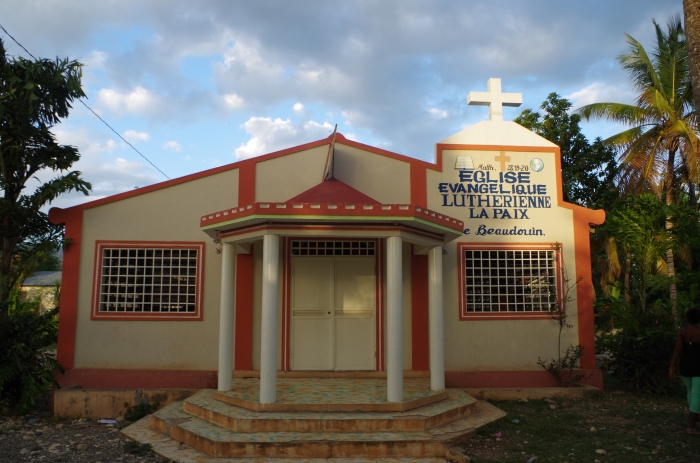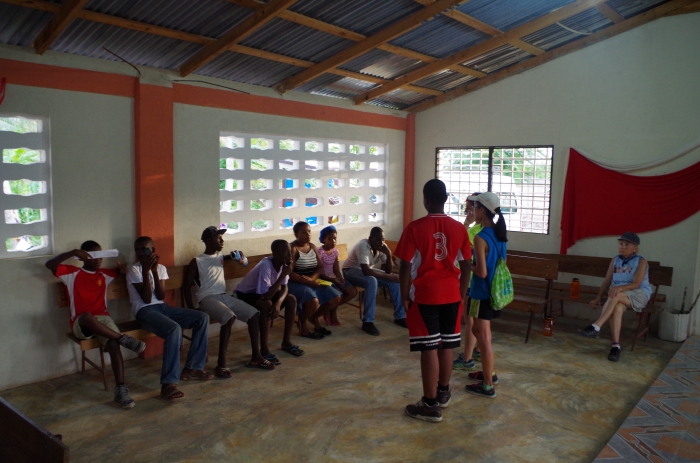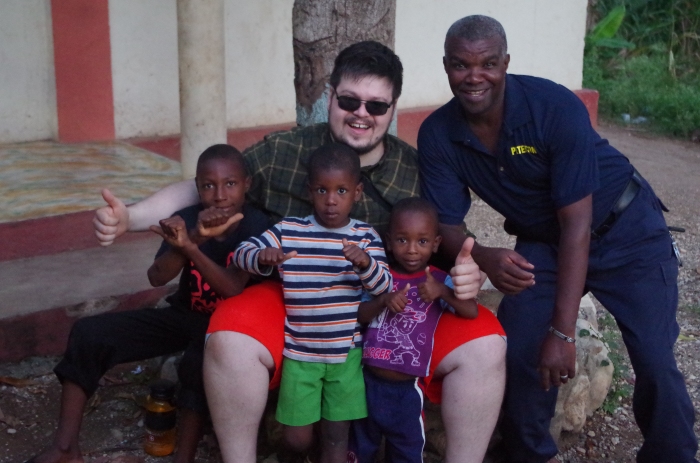Prepare for a very lengthy post; mostly due to our having a WILDLY busy Wednesday in Haiti…
A wall around the orphanage; razor wire atop the wall
After gathering all the orphans, orphanage staff, and our team of volunteers for a group photo…

… we dove into our various tasks for our last workday. The team again took up their assembly line positions between “pile of cement to mix” and “temporary wooden trough atop new wall” and passed buckets of cement to the wall, and empty buckets back. Consider for a moment the sheer scale of the walled compound around the orphanage…

… and then realize that in 4 weeks, my brother Steven organized and led 4 teams of volunteers to 1) Put in a foundation; 2) assemble the wall block by cement block; and in our fourth week 3) drape razor wire and then cement it into place atop the orphanage. All of this also happened in extremely miserable temperatures and high humidity – so this was one SERIOUSLY good job!

The last portion to the security wall around the orphanage compound will be a pair of lockable rolling metal gates, which I hope will come soon to really make the wall operational.


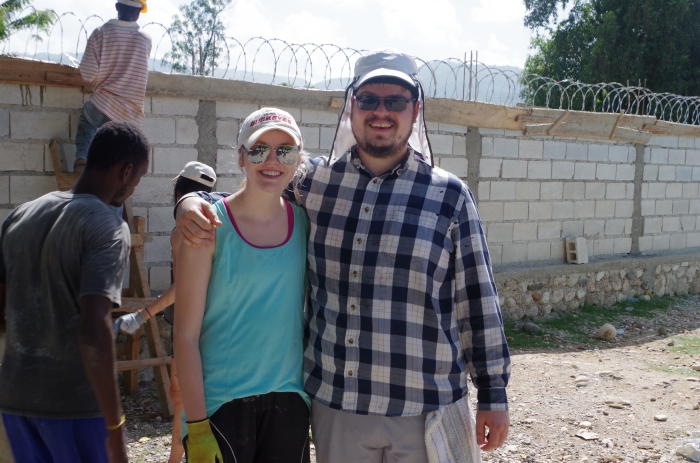
My task at the orphanage was to photograph all the different things going on, but I worked hard to get good action shots (as seen above and below) of this final stage of the wall construction.



The area around Beaudouin was lovely t0 see, with more trees than one often encounters in Haiti given the vast deforestation. It is my hope that this natural abundance can be husbanded over time, but I am not going to hold my breath.


Starting medical charts for the orphans
While the razor wire project continued apace, my brother and our translator Nathan went up to the rooftop of the orphanage, with myself and the local Haitian called the Praying Man (who is looked to both for prayer and medical assistance, given his 15+ years apprenticing with visiting American doctors).

My brother, being the clever young man that he is, recognized the peculiar need of these orphans for as many defenses against ills in their lives as possible and figured out a way to help them medically over their lives to come. In short: he realized that starting medical charts for them in the here and now, even when medical assistance won’t always be available, could prove to be invaluable to saving their lives some day. At the very least, it is passively and actively implying that there is GREAT importance to one’s health and paying attention to it; modeling good behavior is often unexpectedly important to inspiring good behaviors.


Another important aspect to this medical checkup, as the next section will further highlight, was to slyly give training to the Praying Man in the use of the various implements in the deluxe EMT kit my brother had purchased to bring down with him:
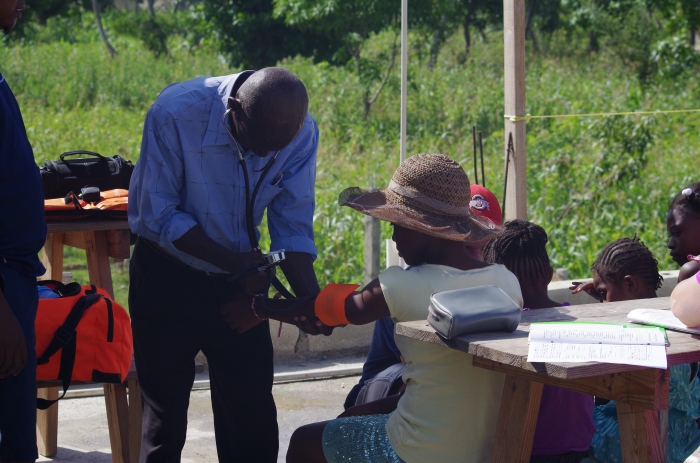
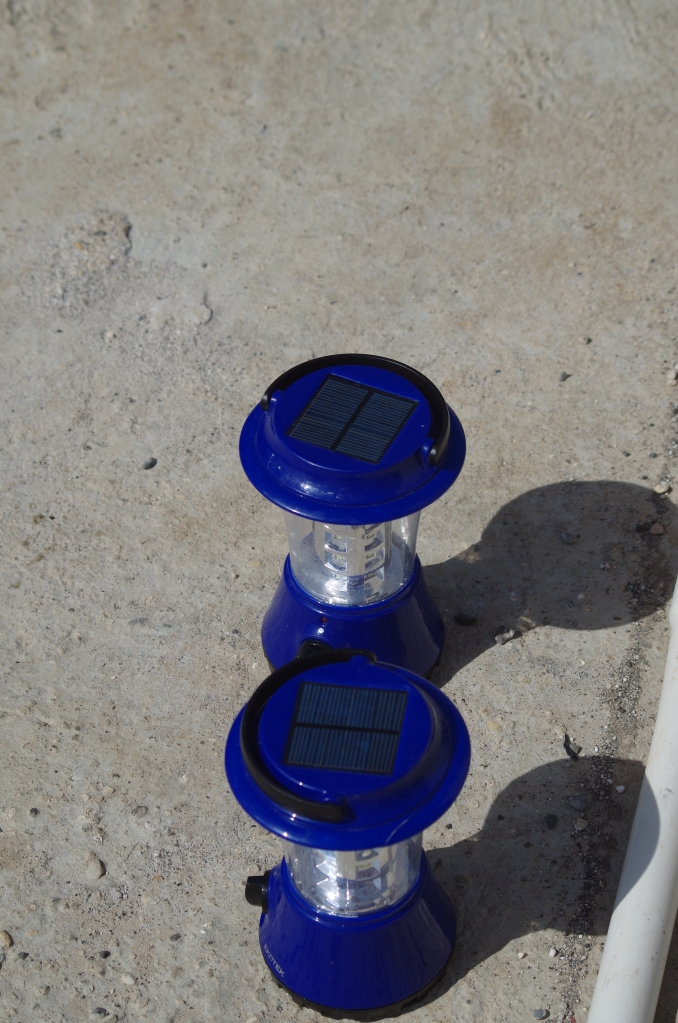
The last few charts done (it was a process my brother had done over the month he was there, for a total of 36 fairly intensive medical charts created), the next experience really warms my heart.
The Praying Man, the (surprised!) proud new owner of an extensive EMT kit
Andrea, Steven, Nathan and I took a quick side trip at this point, for another emotional moment of growing in partnership and trust with one another. The lady who we visited, at 88 years old was FAR beyond the Haitian life expectancy of 65 years old. She was only complaining of aches and pains across her whole body (likely osteoporosis), which is a slim list of symptoms compared to what she could be experiencing. After giving her painkillers and instructions, we stepped back outside for a special moment…

My brother, talking through our translator and friend Nathan, explained that based on his many years of apprenticing and his decades of serving as a bastion of prayer and care within the community, let the Praying Man know that we are entrusting him with the EMT kit and the responsibility for the health of his fellows which it entails:



Just like the razor wire wall as an edifice, and the ESL classes continuing long after our teams depart… it is my sincere hope that the Praying Man with his new orange bag of medical salvation shall be another sustainable outcome for good from our work in Haiti.
A brief chance to drive in Haiti
As my blogs and Facebook have indicated more and more over the past months and perhaps 2 years, automotive mechanical projects have become more and more of an interest of mine (a core part of the constellation of being self-prepared for anything and everything)… you can imagine how excited I was to have the chance to drive a stick shift vehicle on the VERY rough roads!!


A Jaunt into the Haitian Mountains; my own personal lecture on Vodou
So.
In the midst of an already super busy day (something not mentioned above – I got to do some emergency file recovery when the ESL final exam file got corrupted; and then walk back and forth to the local Jacmel print shop in the heat to get the tests printed for the evening’s exams), I was privileged to have the chance to take a drive with our good friend Nathan to the beach and Jacmel art district; and then up to the mountaintop leading to Bassin-Bleu, so I could grab some good photos of the city as a whole, the coast, and the views.
Quite delightfully, Nathan was happy to discuss all manner of topics: from his impending seminary education to become a Lutheran pastor, in the US (next year; very exciting for him!!)… to the Haitian iteration of “voodoo” (which is more correctly rendered “vodou”), and so without further ado, here is my own personal introduction to Haitian…
Vodou
As a disclaimer, the following does not purport to be a systematic exposition of the Haitian vodou belief system. This was the tale as told by one Haitian man, as remembered by me a week after the fact, and without anywhere CLOSE to enough time to get the full story.
Vodou, somewhat like the language Creole, is the process of “creolization” – the syncretic combination of a series of distinct ideas and content into one combined mass. Haiti, at one point, produced something like 45% of the sugar consumed by Europe – because it was an island covered in slave plantations for sugar cane, run by the French. The slaves, as Nathan told it, were intentionally split apart from their fellow tribe members once in Haiti, to discourage resistance (not least of all because different tribes spoke incompatible languages)… and given the sheer number of tribes who had members sent to Haiti as slaves, that means a LARGE bank of indigenous African tribal religious beliefs got uprooted and again planted into Haitian soil.
These different tribes, very generally speaking, had a STRONG worldview based on the presence of spirits good and ill in and around the powerful things around them (the weather; large animals; large trees or mountains; and more). Monotheism didn’t really have a place to develop amongst such a pluralistic set of faith communities. Quite the opposite, the developing Haitian vodou pantheon had many seats to start and kept making more and more. One of the trees we drove past on the way up the mountain towards Bassin-Bleu, for instance, is simply gigantic: and, as Nathan explained, it is quite certainly a site for vodou veneration and ceremony. Based on its majestic size and stature, it is assumed to have a big and powerful spirit (“loa” as they are called in vodou) animating and/or protecting it… a spirit powerful enough to worry about if it gets angry. And so, in a very materialistic sort of way, the tree is propitiated by those ceremonies and rituals:

It may sound odd, to speak of a materialistic bent to the vodou tradition given the above emphasis on spirits. But vodou very often takes a serious approach to the practical problems of everyday life. Nathan shared at length the story of his father talking with a vodou priest. The priest went to a woman’s house who complained that in the middle of the night, time and again, she was awoke by the dishes in her closed cupboard clattering. The priest explained that she had to buy a certain candle and ONLY use it for this purpose; and then get a certain nice kind of drinking vessel also to be used solely for this spiritual intervention. Twice a day she needed to face a certain corner of the house, light the candle and drink all the water she could fit into the drinking vessel. The priest explicitly told her “this will get rid of your problem.” But, it is fascinating to note, he explained to Nathan’s father that he was lying to this woman. He explained: “I don’t want to worry her, but the fact of the matter is that the spirit rattling the dishes was not going to leave just because of ME or MY instructions. Quite the opposite: the tasks I gave to this woman were merely to satisfy the restless spirit residing in or perhaps near the house. Nothing and no one will move it, all we can do is try to make it comfortable so it leaves us alone.” In a weird way, this sort of strong emphasis on spirits… is actually as means to materialistic ends. The spirits are all real, can be REALLY annoyed and thus in need of propitiation… but we just gotta deal with them in this life as we try and go about said life.
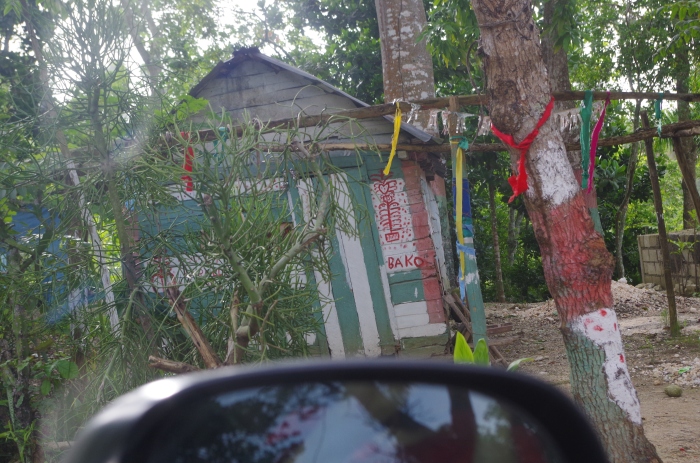
I mentioned monotheism above (the notion that only one god exists and is worthy of praise). The French and other colonial nations on Hispaniola all made efforts to convert the slave population to Catholicism, and something interesting happened. On the one hand, Haitian vodou is at its core the amalgamation of many other faiths into one general disposition on the world and the spirits within it. On the other hand, the Catholic church was (and still is) surprisingly flexible when it comes to incorporating local belief and tradition into its attempts at missions amongst non-Christian (think, for instance, of all the locality-specific iterations of “Our Lady of Guadaloupe”). As you might imagine: these two religious blocs being willing to meld into or with other beliefs… led to some SERIOUS syncretism between Catholicism and vodou. Haitians would “convert” to being Catholic but in every conceivable way map the various core loa (spirits) within vodou onto the saints, Mary, and even Jesus of the Catholic faith. This syncretism was so complete for so long that even today, Haitian Christians actually do not consider Catholics to be Christian. Nathan confessed some worry, because as a Lutheran Haitian even he is sometimes under suspicion because of the similarities between Catholic and Lutheran denominations. That is a STRONG association between Catholic and vodou beliefs, I daresay.
Finally, rather than monotheistic, I would call Haitian Christians (and vodou practitioners alike) “monolatristic,” just like the Israelites of Exodus. They believe in one god above all other gods and spirits… but in a very real, visceral way, they also believe in the presence and power of ALL sorts of other spirits. It was particularly interesting to hear about some of the commonly-held beliefs of Haitians regardless of religion. The presence of electric lights, or perhaps urban areas in general, are inimical to the operations of the evil spirits associated with/venerated by aspects of vodou. Thus, as Christianity has spread to the cities and even towns of Haiti, vodou has been pushed to the backwater, upper mountain regions. Not to be crass, but ALL Haitians act on the reflexive belief that after urinating, you have potentially exposed yourself to losing some of your vitality and power… and so will spit after urinating. Even Haitian Christians, who consider this a false and indeed silly belief… still end up doing it. It is THAT ingrained in the culture!
As I started by saying, not a complete or academic presentation on vodou, the above is just the description and details I picked up from Nathan… but I certainly think it was an interesting introduction!!!
Exploring the mountains, a breathtaking view of the coast
The core purpose of the drive on which I got such an interesting education in vodou and Haitian beliefs, however, was to get some glorious photographs of the scenic and natural gems of Haiti. And hoo boy, let me tell you, I got some good photos!!
We started at a nearby hotel, where we sort of talked our way in to get photos of the coast:


We then drove down to the beach in front of the Jacmel art district, with a view of the port of Jacmel (it is “legally closed” by the national government, but a local very rich family apparently still runs commercial ships into it for themselves. As I have said many times – Haiti is all sorts of corrupt), with a FANTASTIC wind off the sea:


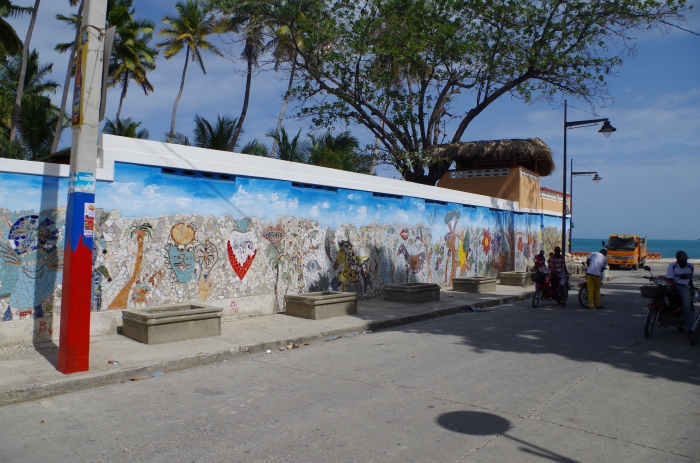
Finally, we took the more circuitous route up some SEVERE inclines, some rough “roads,” and generally speaking an absolute lack of guardrails or other safety infrastructure.
It was all so, so worth it:



One of the general benefits of a mission/volunteerism trip like this is a WILD perspective shift anyways; how cool it was to step outside of the tall walls of the streets of Jacmel and get far enough away to struggle to even see the city!
Having lost track of time due to transit time and engrossing conversation alike, Nathan and I were suddenly called that we were already late in returning! So, we started the circuitous and dangerous trek back down the STEEP mountain:

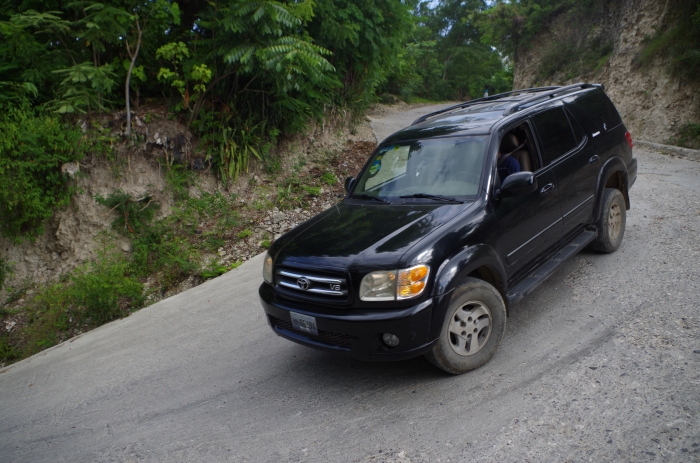
Even on the way down, and in the midst of a hazy day, the views were simply spectacular:

We also got a really great look at the Bridge Which Goes Nowhere. A foreign aid program to build a safe bridge from the main road to the mountain where we were coming down from, the money was mismanaged to the point that mid-construction, the bridge was left unfinished. The photo below shows the side where a gravel embankment has been created to one side of the bridge… the far side of the bridge is simply a dead end hanging up in the air. It is for this sort of reason that Steven and the teams of volunteers placed such a high premium on finishing all the projects we started: that sort of achievement is VERY noteworthy in Haitian culture.
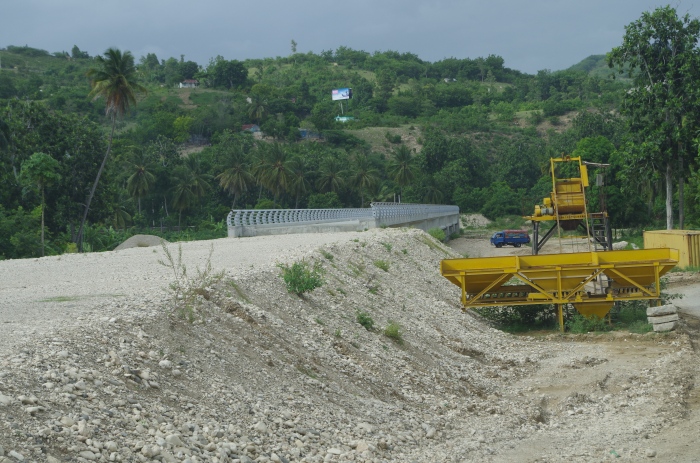
English as a Second Language (ESL) graduation ceremony!!!
Nathan and I, after nearly running out of fuel in the mountains (we were traveling on fumes and dreamy memories of petrol at the end of our drive) and refueling in town, made it back to the guest house, whereat we jumped back in the car and rushed over to Beaudouin. There, the ESL students were working hard through their final exams:
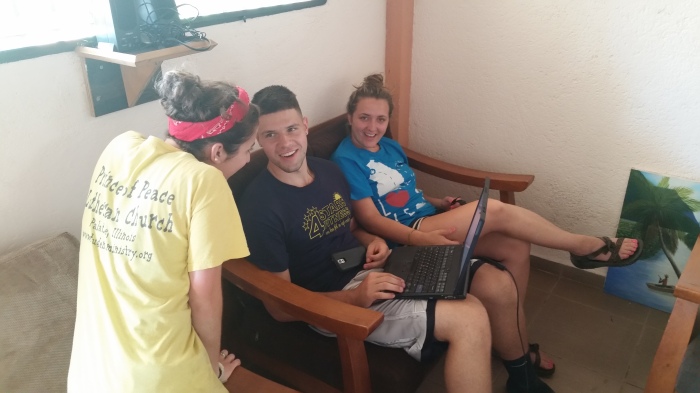

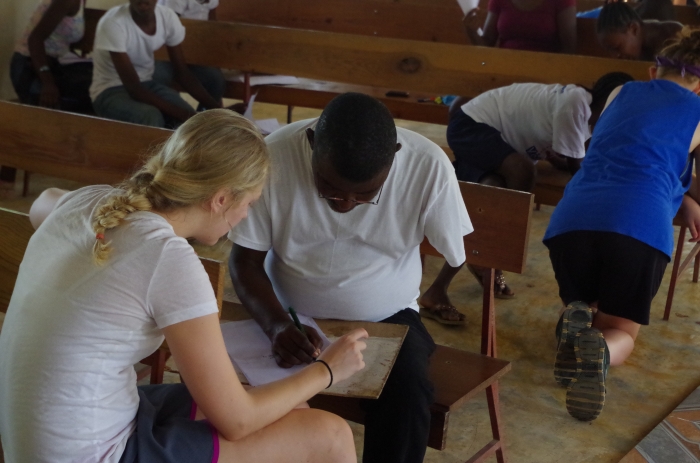
After the test, we had a few speeches from Steven, Valdo (below, the local Haitian who would continue the program after we leave) and others, the real payoff was seeing the pride on the faces and body language of those graduating from their respective levels of proficiency.

It is my contention that given the sheer joy of those Haitians who participated and their pride at having learned so much English in such a short time, that I want to give a space on this blog post to display the photos of each and every person with their certificate (unfortunately, I do not have all of their names, else I would give first names with each photo):
After the end of the closing ceremonies, we were treated to a very emotional and rousing rendition of the Haitian national anthem. Unfortunately I only captured that small clip of it, but the level of enthusiasm for the their nation from those impoverished Haitians in the ESL class honestly surprised me. I was expecting more bitterness or frustration at the low level of governmental effectiveness; I can’t say for sure, but perhaps the belting out of the anthem was more of a vote of confidence in the nation of Haiti than its government? In any event, these very poor people were astonishingly generous – they surprised us by gifting each of us a Haitian flag (at $2 each, which is ~1 day’s labor for a pretty well-paid laborer, that is a LOT of money to have freely given us), which we used to participate in our own way in the singing of the anthem.
For those who don’t like a video, here is a still photo of that moment, flags all waving aloft with the rhythm:
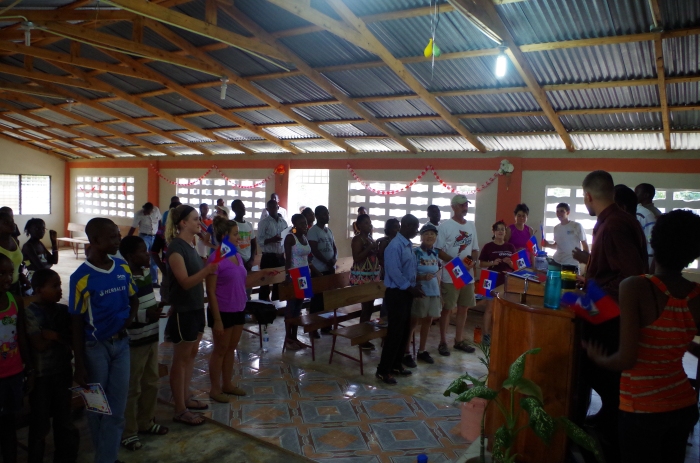
One of the most special moments of the trip then happened, in my opinion. My brother was given a hand-made wooden desk ornament, to thank him for all his VERY hard work preparing for and then leading 4 weeks of volunteers in a foreign country. I am very, very proud of him:

We stepped outside in a jovial atmosphere, got a couple of final photos and said our goodbyes, and then the team departed for Pastor Marky’s restaurant in Jacmel.


A closing meal at Pastor Marky’s Chandelier Restaurant in Jacmel
The meal we drove to was VERY much anticipated by the team, famished at this point. And I can promise you: we weren’t disappointed. A huge spread of delicious food in a delightful atmosphere with our new Haitian friends: definitely a magical sort of ending to a hard week spent working.

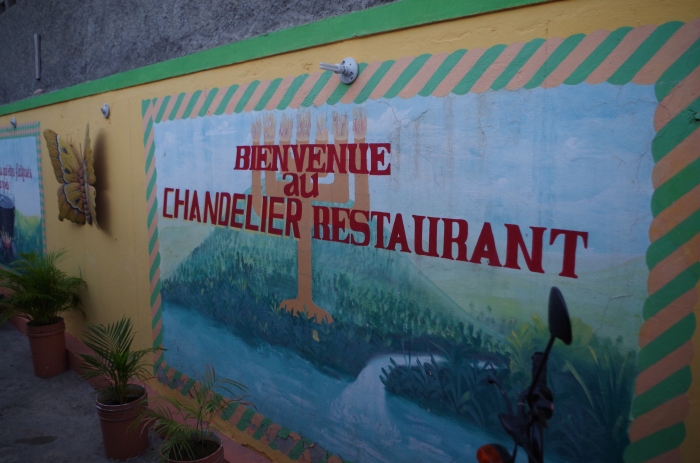
The DELICIOUS meal served to us at Pastor Marky’s restaurant

We took a couple of further steps towards enjoying ourselves regardless of social cost: we sang the song and danced the dance associated with “La Touche.” I am not sure where this song came from, but the basic principle was to use silliness and a combination of French and English in the song with body movements to teach the English names of various major body parts. Good for a bunch of laughs? Yes. Good for teaching the major body parts to Haitians in English, so they might be able to help a future American volunteer doctor to diagnose them? Very yes!

Later that night, back at the Guest House…
… I did indeed continue to work on fixing computers, my last chance to do so, until after 1am. At this point I was working to fix the personal machines of the pastors and some close Haitian friends of the guest house, all of whom I wanted to help. The reality, of course, is that there are limited hours in the day and I had a limited set of discs and flash drives with which to effect repairs. I couldn’t fix all the computers in need of work (likely: most of them in Haiti, given the computing tendencies I described in a previous post), but damn if I didn’t try!!
The evening closed with me going into a coma after packing up my stuff to prepare for our departure from Jacmel on the morning to come.




